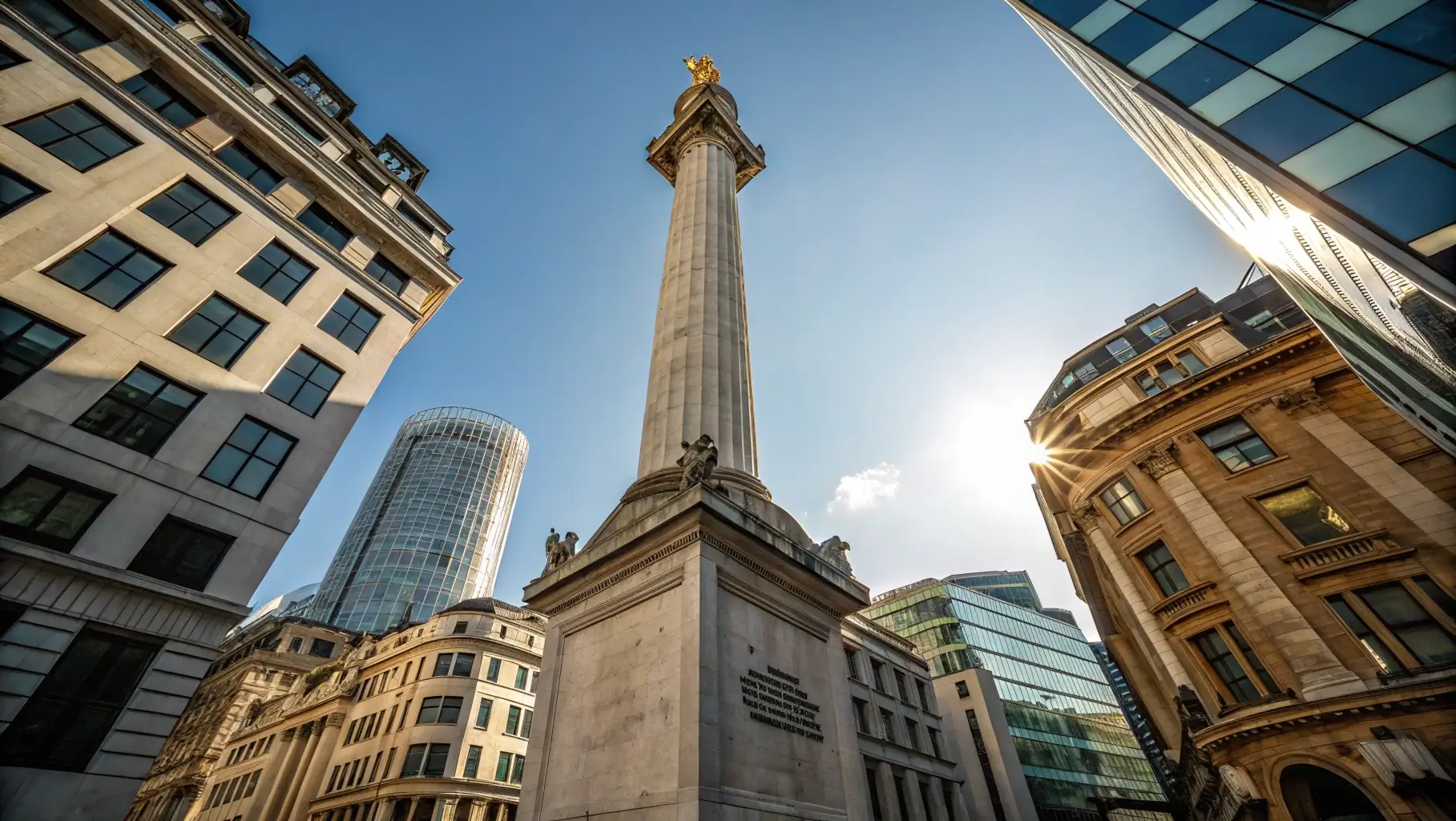Rising majestically above the bustling streets of London stands a remarkable testament to human resilience and architectural brilliance—the Monument to the Great Fire of London. This towering Doric column not only commemorates one of history’s most devastating urban disasters but also offers visitors an opportunity to climb 311 steps for breathtaking panoramic views of the city. Standing near the site where London’s great conflagration began in 1666, the Monument represents both remembrance and rebirth, making it an essential landmark for anyone seeking to understand the soul of this historic metropolis.
Table of Contents
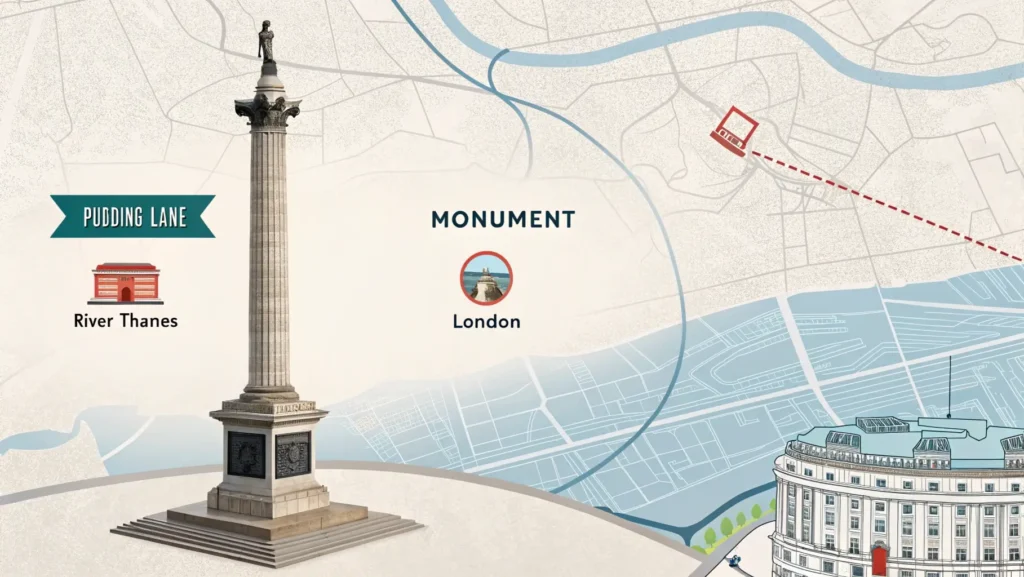
Quick Facts & Key Information
| Feature | Details |
|---|---|
| Location | Fish Street Hill, London EC3R 8AH |
| Architects | Sir Christopher Wren and Robert Hooke |
| Height | 202 feet (61.5 meters) |
| Number of Steps | 311 |
| Year Built | 1671-1677 |
| Opening Hours | 9:30 AM – 6:00 PM (April-September)<br>9:30 AM – 5:30 PM (October-March)<br>Check official site for latest hours |
| Ticket Price | Adults: £5.80, Children (5-15): £2.90, Concessions: £4.20<br>Book tickets online |
Why Visit the Monument?
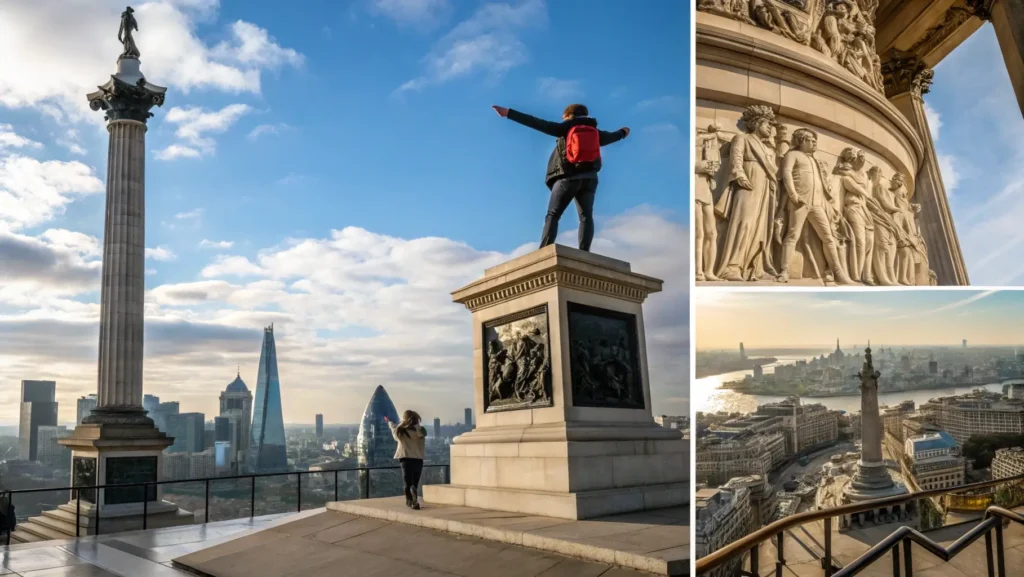
The Monument offers visitors several compelling reasons to include it in their London itinerary: “monument to the great fire of london”
- Historical Significance: Stand at the exact location where one of history’s most transformative urban disasters began—a pivotal moment that reshaped London forever
- Architectural Wonder: Marvel at one of Sir Christopher Wren’s ingenious designs that doubles as both memorial and scientific instrument
- Panoramic Views: Reward yourself with spectacular 360° views of London’s skyline after conquering the spiral staircase
- Value for Money: At under £6 for adults, it’s one of London’s most affordable elevated viewpoints
- Physical Challenge: Feel a sense of accomplishment after climbing the 311 steps to the viewing platform
- Hidden Gem: Escape the crowds of more famous London landmarks while experiencing authentic London history
The Deep Dive: History & Significance
The Great Fire of London: A City in Flames
In the early hours of Sunday, September 2, 1666, a small fire broke out in Thomas Farriner’s bakery on Pudding Lane. What began as a minor incident quickly escalated into a catastrophic inferno that would rage for four days, consuming over 13,200 houses, 87 parish churches, St. Paul’s Cathedral, and most government buildings. When the flames finally subsided, approximately 80% of London within the old Roman walls lay in ruins.
Remarkably, while the physical devastation was immense, officially recorded deaths numbered fewer than ten. However, historians believe many more perished, with remains lost in the intense heat or victims going unrecorded among the poor and marginalized population.
Conception & Purpose
In the aftermath of such destruction, London faced the monumental task of rebuilding. King Charles II and the City authorities recognized the need not only to reconstruct but also to commemorate this pivotal moment in London’s history. The Monument would serve multiple purposes:
- A permanent memorial to remember the devastating fire
- A symbol of London’s resilience and rebirth
- A scientific instrument for astronomical observations
- A statement of architectural prowess and civic pride
The location was carefully chosen—just 202 feet from Pudding Lane where the fire began. In fact, the Monument’s height (202 feet) exactly matches this distance, creating a direct physical relationship between the memorial and the disaster’s origin point.
The Designers: Wren & Hooke
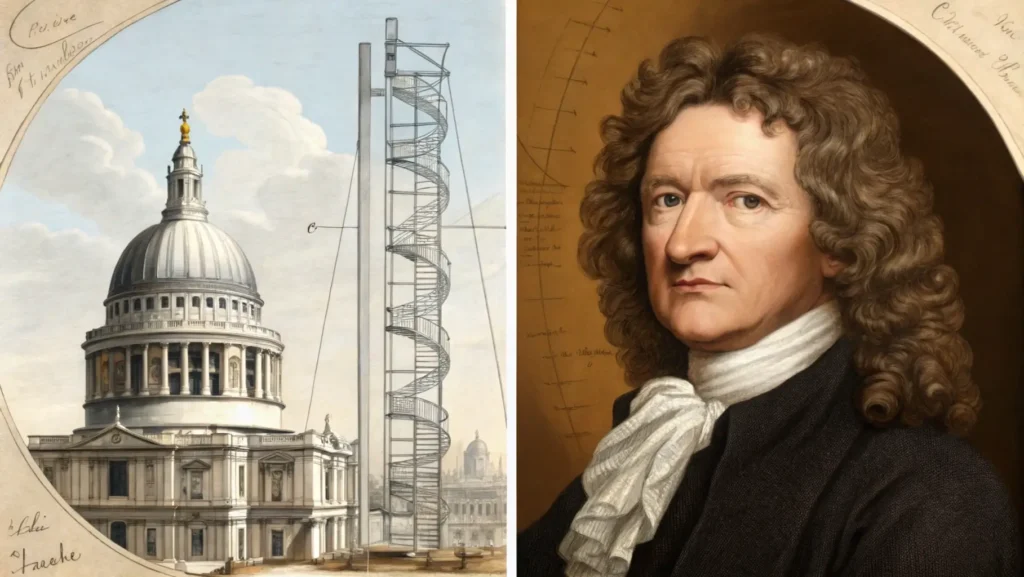
The Monument represents a fascinating collaboration between two of the 17th century’s greatest scientific and architectural minds:
Sir Christopher Wren (1632-1723), already famous for his mathematical and astronomical work, would later become England’s most celebrated architect. Following the Great Fire, Wren submitted comprehensive plans for rebuilding London. While most of his grand vision for a city of wide avenues and geometric order was rejected as impractical, he did secure commissions for 52 new churches and St. Paul’s Cathedral. The Monument showcases Wren’s genius for combining symbolic meaning with practical purpose. Wren’s architectural legacy is explored in detail by the Royal Institute of British Architects, which highlights his influence on urban design and the reconstruction of post-fire London.
Robert Hooke (1635-1703), a polymath whose contributions spanned architecture, physics, astronomy, biology, and more. As Wren’s friend and collaborator, Hooke brought his scientific expertise to the Monument’s design. His work on the microscope (documented in his groundbreaking “Micrographia”) and laws of elasticity informed the Monument’s dual purpose as both memorial and scientific instrument. Hooke served as London’s Chief Surveyor and played a crucial role in rebuilding the city.
Together, these remarkable minds conceived a structure that was far more than decorative—it was functional, symbolic, and mathematically precise.
Design & Symbolism Explained
The Doric Column
Wren and Hooke selected the Doric order—the most austere and strongest of the Greek architectural orders—to symbolize London’s strength and resilience. This choice was deliberate, reflecting classical ideals of permanence and stability in contrast to the transient nature of the wooden structures that had fueled the Great Fire.
The fluted column shaft rises from a square pedestal adorned with bas-reliefs and inscriptions. The proportions follow classical rules, creating a visually harmonious structure that commands attention without overwhelming its surroundings.
The Flaming Urn
Crowning the Monument is a large gilded brass urn with sculpted flames erupting from its top. This dramatic finial represents the fire itself, transformed from destroyer to purifier. In classical symbolism, fire represents both destruction and renewal—a perfect metaphor for London’s experience. The original design called for a statue of Charles II, but this was rejected in favor of the more symbolic flaming urn.
The Inscriptions
The Monument features several Latin inscriptions that tell the story of the Great Fire and London’s subsequent rebirth. The most notable inscription on the north panel originally included text blaming “the treachery and malice of the Popish faction” for the fire—a controversial accusation reflecting the anti-Catholic sentiment of the time. This inflammatory text was eventually removed during the reign of James II and permanently erased in 1830. Historic England provides an in-depth listing of the Monument, including details on its inscriptions and architectural classification as a Grade I listed building.
The main inscription, when translated, provides a detailed account of the fire’s progress and destruction, stating:
“In the year of Christ 1666, on the 2nd of September, at a distance eastward from this place of 202 feet, which is the height of this column, a fire broke out in the dead of night which, driven by a strong wind, consumed the adjacent parts and even places far removed, with incredible noise and fury…”
The inscription continues to describe how the fire spread, the destruction it caused, and how London rose from the ashes “in the third year, already giving signs of its future splendor and wealth.”
The Monument as Scientific Instrument
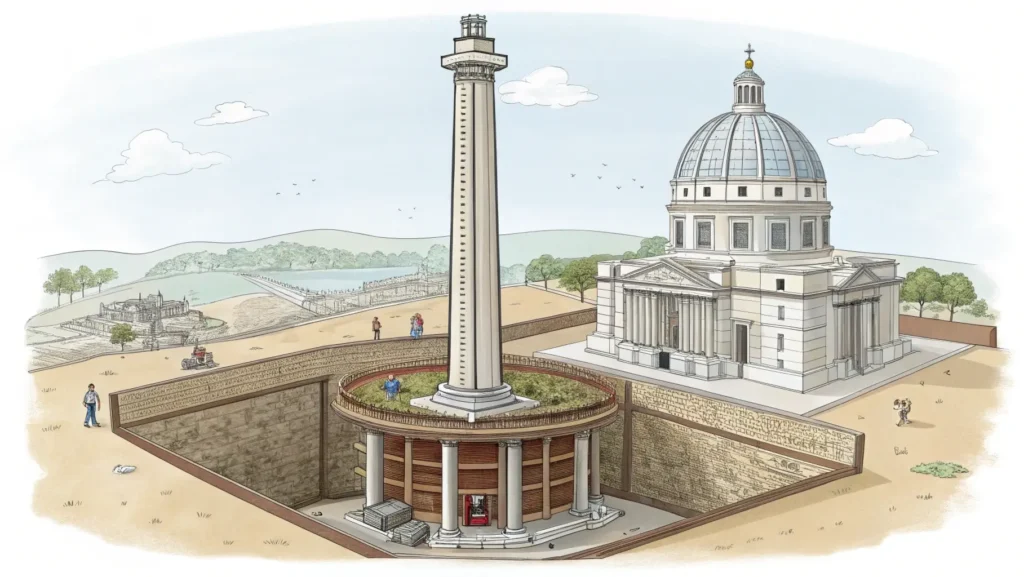
One of the most fascinating yet often overlooked aspects of the Monument is its function as a zenith telescope—a vertical telescope designed to observe stars directly overhead. Hooke, with his scientific background, incorporated a central shaft running the entire height of the column. Initially, his plan was to use this shaft for several experiments:
- Astronomical observations: The shaft would allow stars to be viewed in daylight from the underground laboratory
- Barometric experiments: To measure atmospheric pressure variations
- Pendulum experiments: To test gravitational theories, Hooke’s scientific contributions, including his involvement with the Royal Society, are documented in their historical archives.
The underground laboratory still exists, though it is not open to the public. Unfortunately, the telescope function proved impractical. Urban vibrations from nearby traffic made precise observations impossible, and London’s notorious smoke and fog limited visibility. Nevertheless, this dual-purpose design represents a remarkable fusion of commemoration and scientific inquiry characteristic of the early Royal Society era.
Construction & Challenges
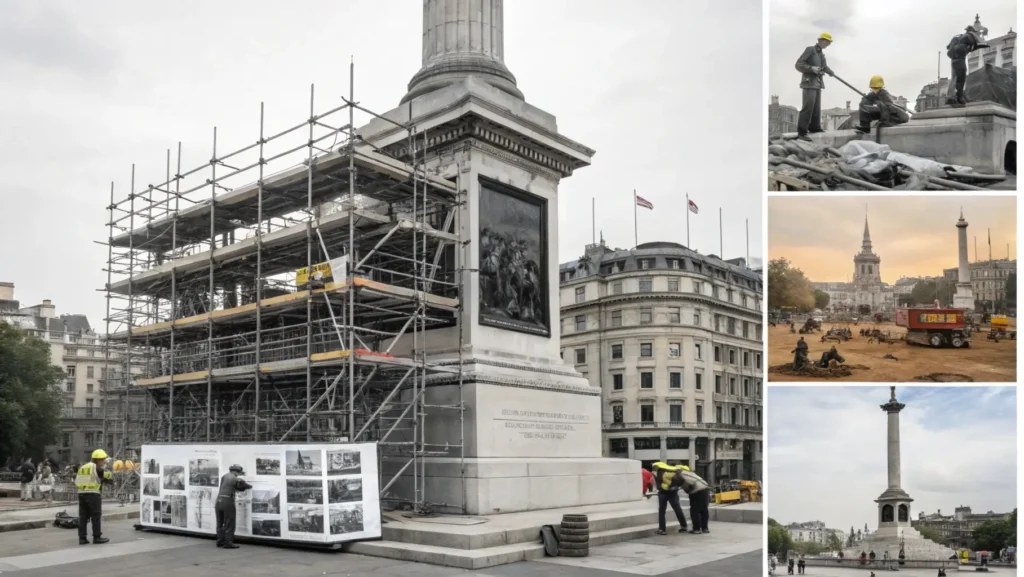
Work on the Monument began in 1671, five years after the Great Fire. The construction process faced numerous challenges:
- Material sourcing: Portland stone was selected for its durability and fire resistance—a pointed contrast to the timber that had fueled the Great Fire
- Structural engineering: Creating a stable column of such height required innovative engineering solutions
- Precision construction: The central shaft needed perfect vertical alignment for its scientific function
- Cost management: The final cost of £13,450 (equivalent to millions today) required careful budgeting
Construction was completed in 1677, taking six years rather than the anticipated two. This delay reflected both the technical challenges and the massive rebuilding efforts occurring simultaneously throughout London.
The Monument Through Time
Over its 350-year history, the Monument has witnessed London’s transformation from a relatively compact city to a sprawling global metropolis. Key moments in its timeline include:
- 1679-1680: First scientific experiments conducted in the underground laboratory
- 1684: First tourist descriptions appear in diaries and letters
- 1732-1733: First major repairs conducted
- 1810: Iron railings added to the viewing platform after several suicides
- 1834: The monument survived the nearby burning of Parliament
- 1843: Complete restoration and cleaning
- 1939-1945: Survived the Blitz despite nearby bomb damage
- 1977: Tercentenary celebrations
- 2007-2009: Major conservation project including stone cleaning and repair
Throughout these centuries, while the surrounding cityscape dramatically changed, the Monument has remained a constant reminder of London’s capacity for renewal.
Planning Your Visit
Getting There
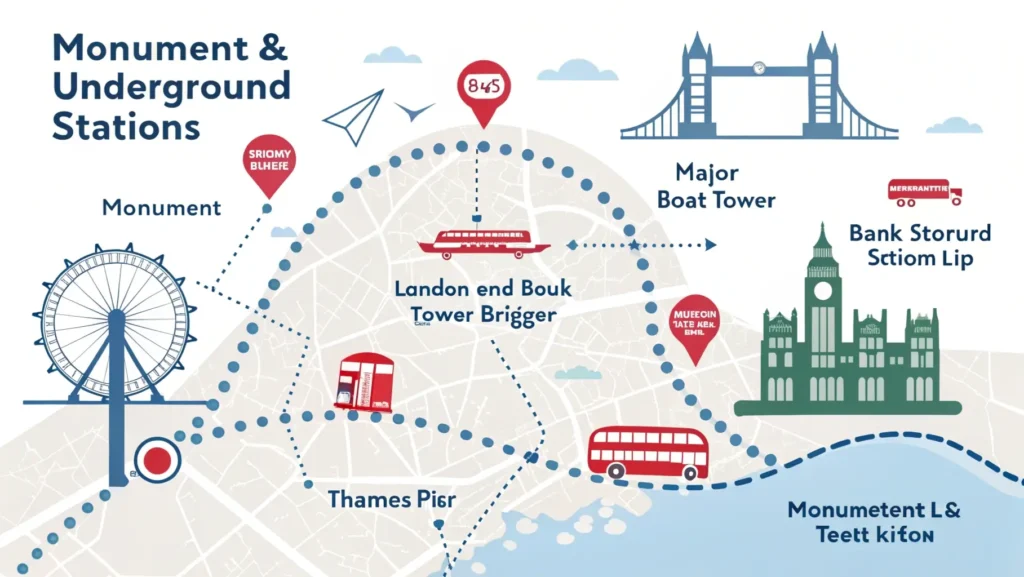
The Monument is conveniently located in the heart of the City of London, making it easily accessible by public transportation:
By Underground (Tube):
- Monument Station (Circle and District lines) – Literally at the foot of the Monument
- Bank Station (Central, Northern, DLR, Waterloo & City lines) – 5-minute walk
- London Bridge Station (Northern, Jubilee lines) – 10-minute walk
By Bus: Several bus routes stop nearby, including 17, 21, 35, 43, 47, 48, 133, 141, 149, and 521
By River:
- Tower Pier – 10-minute walk from Thames river services
By Foot:
- From Tower Bridge: 12-minute walk
- From St. Paul’s Cathedral: 15-minute walk
- From London Bridge: 8-minute walk
Tickets & Prices
Individual Tickets:
- Adults: £5.80
- Children (5-15 years): £2.90
- Concessions (Students and Seniors): £4.20
- Under 5s: Free
Joint Tickets (with Tower Bridge):
- Adults: £12.30
- Children: £5.80
- Concessions: £8.90
Tickets can be purchased on-site or booked in advance through the official website. The Monument is also included in several London attraction passes, including the London Pass.
Opening Times
Summer (April-September):
- Monday to Sunday: 9:30 AM – 6:00 PM (Last admission 5:30 PM)
Winter (October-March):
- Monday to Sunday: 9:30 AM – 5:30 PM (Last admission 5:00 PM)
Closures:
- December 24-26
- Occasional closures for maintenance (check the official website before visiting)
Best Time to Visit
For the optimal experience, consider these factors when planning your visit:
For Fewer Crowds:
- Weekday mornings (especially Tuesday-Thursday)
- Outside of school holidays
- Winter months (November-February, excluding Christmas period)
For Photography:
- Morning light (9:30 AM – 11:00 AM) provides excellent eastern views toward Tower Bridge and the Tower of London
- Late afternoon light (3:00 PM – closing) beautifully illuminates western views toward St. Paul’s
- Clear days after rain often offer the best visibility across London
Weather Considerations:
- Strong winds can make the viewing platform experience less enjoyable
- Foggy days severely limit visibility but create atmospheric photographs
- The staircase is entirely enclosed, making it a viable wet-weather option
What to Expect: The Climb
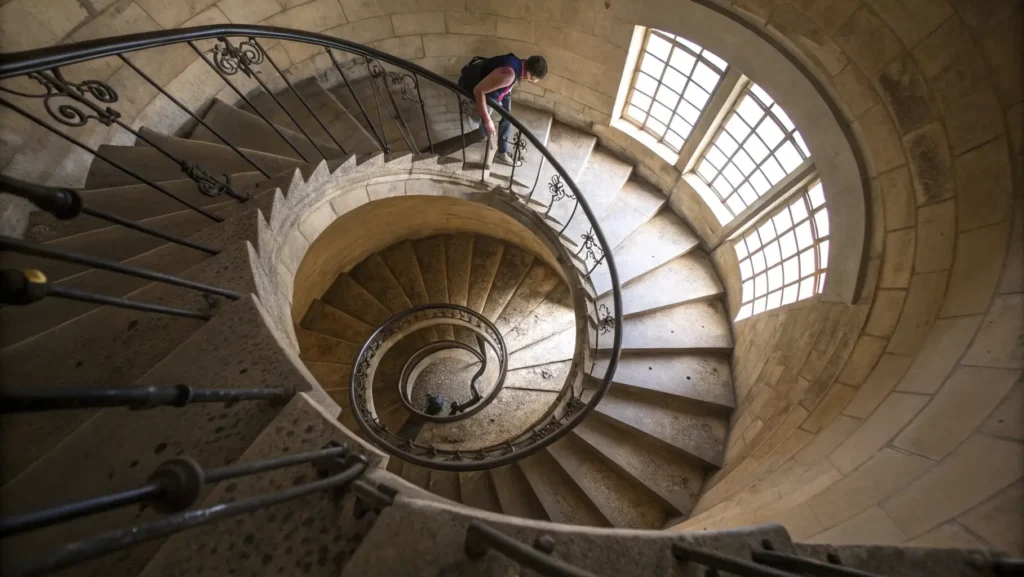
The Monument’s spiral staircase presents a moderate physical challenge that rewards persistent climbers with spectacular views. Here’s what to expect:
The Staircase:
- 311 stone steps arranged in a tight spiral
- Narrow passage (approximately 30 inches/76cm wide)
- Iron handrail running up the central column
- Small windows providing occasional natural light
- Several landings where you can briefly rest
Climbing Tips:
- Wear comfortable, non-slip shoes
- Maintain a steady pace rather than rushing
- Use the handrail for stability
- Allow faster climbers to pass when possible
- If you need a break, use the landings rather than stopping on the stairs
- Bring a small water bottle, especially in summer
Important Considerations:
- Those with claustrophobia may find the tight spiral challenging
- The climb isn’t suitable for those with mobility issues or certain health conditions
- Children should be closely supervised
- During busy periods, two-way traffic on the stairs can be congested
Most visitors complete the climb in 5-10 minutes, depending on fitness level and how frequently they stop. The sense of accomplishment upon reaching the top is part of the Monument’s unique appeal!
The Reward: The Viewing Platform
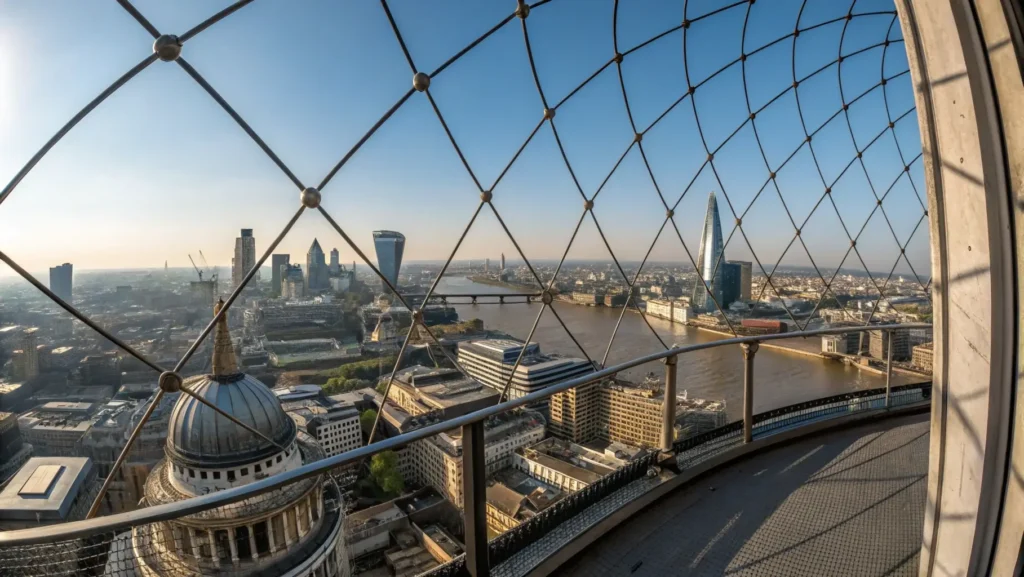
After conquering the spiral staircase, you’ll emerge onto the viewing platform, encased in a protective iron cage (added in the early 19th century). The 360° panorama is truly spectacular, offering a fascinating perspective on London’s architectural evolution.
Key Landmarks Visible by Direction:
North:
- The Gherkin (30 St Mary Axe)
- The Leadenhall Building (“Cheesegrater”)
- Tower 42
- The cityscape of the financial district
East:
- Tower Bridge
- HMS Belfast
- Tower of London
- The Shard (appearing southeast)
- Canary Wharf in the distance
South:
- The River Thames
- Southwark Cathedral
- Borough Market
- London Bridge
West:
- St. Paul’s Cathedral dome
- The London Eye (in the distance)
- The dome of the Old Bailey
- The BT Tower on clear days
Unlike newer, higher viewing platforms like The Shard or Sky Garden, the Monument offers a more intimate perspective on London’s historic core. The relatively low elevation (160 feet at the viewing platform) means you’re immersed in the cityscape rather than floating above it.
Accessibility
It’s important to note the Monument’s limitations regarding accessibility:
- No elevator/lift access is available
- The narrow spiral staircase makes it unsuitable for wheelchair users
- Those with limited mobility, heart conditions, vertigo, or claustrophobia may find the climb challenging
For specific accessibility queries, contact the Monument staff directly via the official website.
Facilities
The Monument itself offers minimal facilities:
- No public toilets on site (nearest public facilities at Monument Station)
- No café or gift shop within the Monument
- Small information desk at the entrance
However, the surrounding area offers plenty of amenities:
- Numerous cafés, restaurants, and pubs within a 5-minute walk
- Several convenience stores nearby
- Public toilets at nearby Monument Station
Tips for a Great Visit
- Timing: Allow 45-60 minutes for the full experience (including the climb, time on the viewing platform, and reading the historical information)
- Photography: Bring a camera with a wide-angle lens if possible; smartphone cameras may struggle to capture the expansive views
- Weather Check: Check the forecast—clear days offer dramatically better visibility
- Certificate: Don’t forget to collect your climb certificate at the bottom—a nice souvenir, especially for children
- Clothing: Dress in layers as the viewing platform can be significantly windier and cooler than ground level
- Combined Visit: Consider purchasing a joint ticket with Tower Bridge for a full day of elevated London views
Beyond the Monument: What’s Nearby
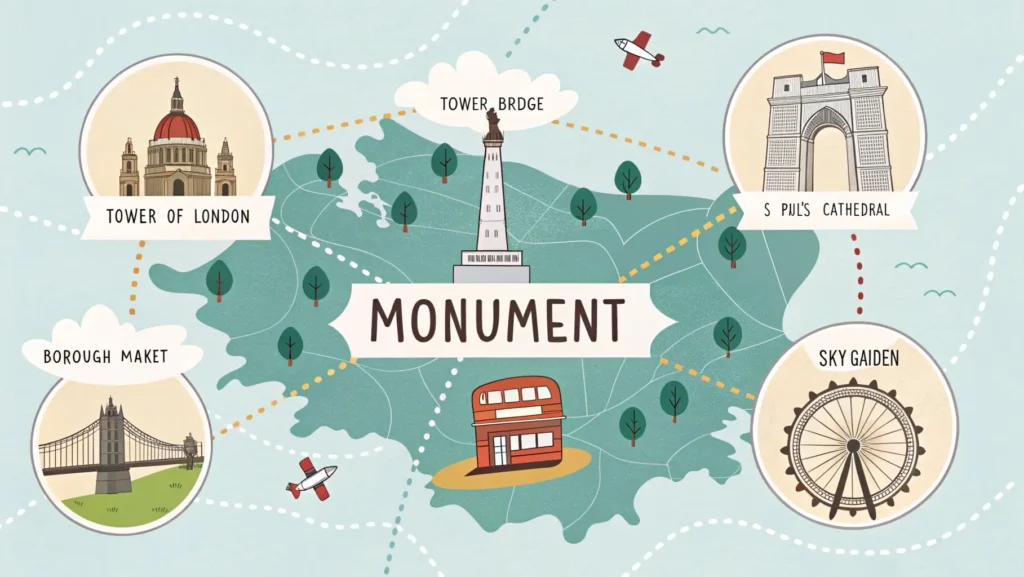
After your visit, several outstanding London attractions are within easy walking distance:
Tower of London (12-minute walk): Home to the Crown Jewels and nearly a thousand years of royal history. The official Historic Royal Palaces website offers current visitor information and historical insights on the Tower of London.
Sky Garden (5-minute walk): Free (but requires booking) elevated garden with spectacular views and restaurants.
Leadenhall Market (7-minute walk): Historic covered market featured in Harry Potter films.
Borough Market (10-minute walk across London Bridge): London’s most famous food market, perfect for lunch after your climb.
Tower Bridge (15-minute walk): Iconic Victorian bridge with a glass floor walkway and engine rooms.
St. Paul’s Cathedral (15-minute walk): Wren’s masterpiece and London’s most famous dome. Visitors can explore Wren’s architectural vision and the cathedral’s history through the official St. Paul’s Cathedral website.
Frequently Asked Questions
How many steps are in the Monument?
The Monument has 311 steps in its spiral staircase, taking visitors from ground level to the viewing platform.
How tall is the Monument?
The Monument stands 202 feet (61.5 meters) tall, a height deliberately chosen to match the exact distance from its base to the site where the Great Fire began on Pudding Lane.
Who built the Monument?
The Monument was designed by Sir Christopher Wren and Robert Hooke, with construction taking place between 1671 and 1677.
Why was the Monument built?
It was constructed to commemorate the Great Fire of London of 1666 and to celebrate the city’s rebuilding. It also served as a scientific instrument for astronomical observations.
Is the Monument worth climbing?
Yes, for most visitors! The panoramic views of central London, combined with the historical significance and sense of achievement, make it worthwhile despite the climb.
Is the climb difficult?
The 311-step spiral staircase represents a moderate physical challenge. Most people of average fitness can complete it with a few short breaks, but it’s not suitable for those with serious mobility issues or certain health conditions.
Can you see St. Paul’s Cathedral from the Monument?
Yes, St. Paul’s Cathedral is clearly visible to the west from the viewing platform.
Why does the Monument have a cage around the top?
The protective cage was added in the early 19th century after several suicides occurred from the viewing platform.
Was the Monument really used as a telescope?
Yes and no. It was designed with a central shaft to function as a zenith telescope, but urban vibrations and London’s air pollution made it impractical for serious scientific observations.
What does the Latin inscription say?
The main inscription details the start and progress of the Great Fire, the destruction it caused, and London’s remarkable recovery. Originally, it also blamed Catholics for the fire, but this controversial text was later removed.
Does the Monument have a lift/elevator?
No, the only access to the viewing platform is via the 311-step spiral staircase.
How long does it take to climb the Monument?
Most visitors complete the climb in 5-10 minutes, depending on fitness level and how frequently they stop to rest.
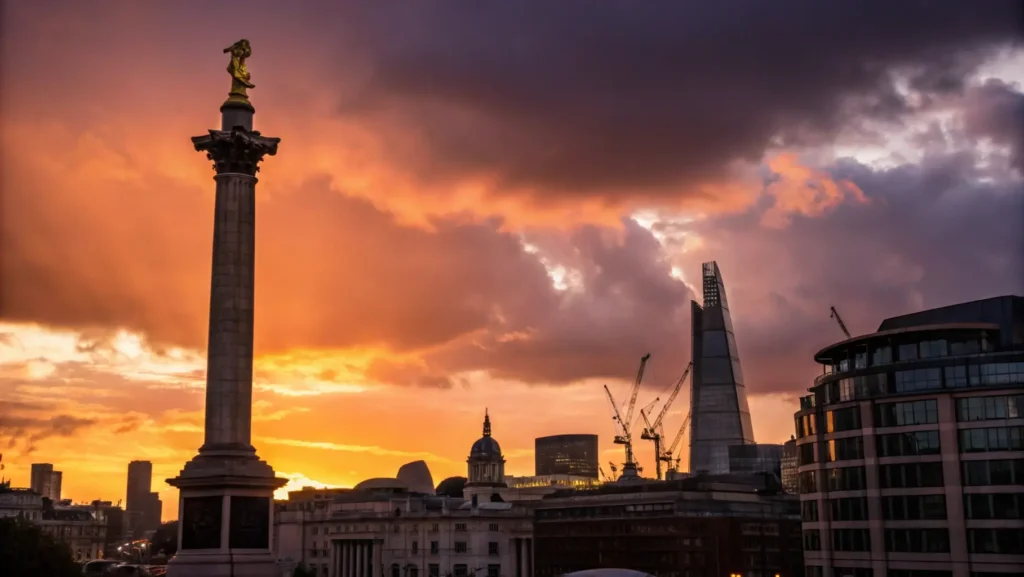
Conclusion: A Symbol of Resilience
The Monument to the Great Fire of London stands as much more than a tourist attraction—it embodies London’s remarkable capacity for renewal in the face of disaster. For over three centuries, this elegant column has reminded Londoners and visitors alike of how the city rose from the ashes of 1666 to become one of the world’s great metropolises.
When you climb those 311 steps, you’re not just ascending for a view; you’re participating in a physical commemoration of London’s transformation. The burning urn atop the column isn’t merely decorative—it’s a powerful symbol of how destruction gave way to opportunity, how tragedy birthed innovation.
In a city constantly evolving and reinventing itself, the Monument remains steadfast—a testament to London’s enduring spirit. Make time during your visit to experience this authentic piece of London history, where architecture, science, history, and urban planning converge in one remarkable structure.
Sources & Further Reading
- The Monument official website
- The Museum of London
- Historic England: “The Monument to the Great Fire of London” listing
- Tinniswood, Adrian. “By Permission of Heaven: The Story of the Great Fire of London”
- Porter, Stephen. “The Great Fire of London”
- Inwood, Stephen. “A History of London”

